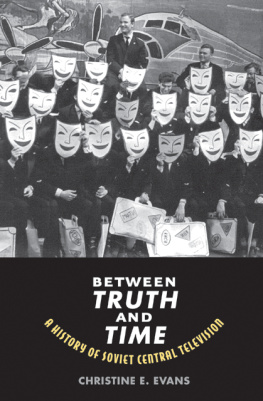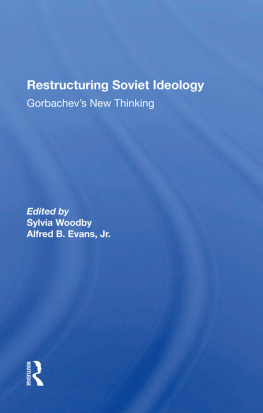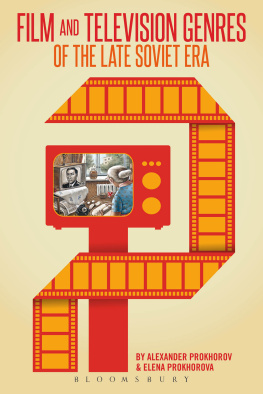
EURASIA PAST AND PRESENT
GENERAL EDITORS
CATRIONA KELLY University of Oxford
DOUGLAS ROGERS Yale University
MARK D. STEINBERG University of Illinois

Published with assistance from the Louis Stern Memorial Fund.
Copyright 2016 by Christine E. Evans.
All rights reserved.
This book may not be reproduced, in whole or in part, including illustrations, in any form (beyond that copying permitted by Sections 107 and 108 of the U.S. Copyright Law and except by reviewers for the public press), without written permission from the publishers.
Yale University Press books may be purchased in quantity for educational, business, or promotional use. For information, please e-mail (U.K. office).
Set in MT Baskerville type by IDS Infotech, Ltd.
Printed in the United States of America.
ISBN 978-0-300-20843-6 (cloth : alk. paper)
Library of Congress Control Number: 2016930748
A catalogue record for this book is available from the British Library.
This paper meets the requirements of ANSI/NISO Z39.48-1992
(Permanence of Paper).
10 9 8 7 6 5 4 3 2 1
For my teachers
CONTENTS

PREFACE

The research for this book began and ended with game shows. When I first traveled to Moscow to begin my research on Soviet Central Television, I found myself in one of the Lenin Librarys innumerable back rooms asking an elderly librarian, What is KVN? I had run into that three-letter abbreviation in the titles of many books in the television and radio section of the card catalog, but these titles offered no clue to the acronyms meaning. What was I to make of a book called KVN?, KVN ... KVN! or What Is KVN? My question caught her off guard. What?! she asked. I cannot even say! I do not even know where to begin! Finally, she answered that it was a television club, a television game, and explained that the initials stood for Club of the Merry and Resourceful [Klub veselykh i nakhodchivykh]. Her response baffled me, for two reasons. First, what was a Soviet TV game show? And second, what could make a game show so significant, so momentous, that it could not be quickly or easily described to a stranger?
In the course of my research, it quickly became clear that Soviet game shows were indeed a serious phenomenon. Borrowed as part of the transnational exchange of successful television formats that arose along with television itself, they also epitomized something important and specific about television in the Soviet Union: its emphasis not solely on propaganda or even just on entertainment, but on play, risk, and experimentation with new rules of the game. Because game shows were entertaining and trivial, and because their participatory and improvisational formats could be linked to the revolutionary mass festivals after 1917, game shows in fact offered a way to think about the future, including a democratic future. I joked to friends that the most interesting thing I had learned about Soviet television in my months of research was that there was so much voting on Soviet game shows and musical contests in the 1970s.
This project became my dissertation before Vladimir Putins third term, before the mass protests against electoral fraud in 201112. Back then, it was easy to see all this voting, these many public conversations about authority to judge, in a quite optimistic lightpracticing democracy, to borrow Margaret Andersons term. But, as Anderson notes, elections always have a dual characterasserting the voting publics role as source of political authority, but also affirming the legitimacy of the state that holds them. As Putins third term wore on, and my dissertation became this book, it has become much easier to see the political experimentation on Soviet Central Television as a precursor to Vladislav Surkovs managed democracy, in which the forms of democratic proceduralism shore up an authoritarian state.
Luckily, however, the game show format in post-Soviet Russia resists this kind of tyrannical presentism. Now that Putin looks likely to remain in power for nearly as long as Leonid Brezhnev before him, at least two aspects of stagnation culture appear resurgent in the Putin era: melancholy, and alongside that response, the rise of experimentation and long-term thinking about other possible futures. As I finished the revisions of this manuscript, both of these sentiments were evident in a small set of Russian TV game shows. In March 2015, I visited the Moscow set of What? Where? When? [Chto? Gde? Kogda?], a Channel 1 game show known since 1977 for its atmosphere of uncensored freedom. The producers choice of musical guest that night reflected growing concerns that What? Where? When? might not be able to retain its critical edge in the new political environment since the annexation of Crimea. The performer was a relative unknown, Paulina Andreeva, singing her first hitthe title track for a 2013 television serial called The Thaw, set during the era of reform following Joseph Stalins death in 1953. Despite its allusion to a long reformist tradition, I was struck by the songs overwhelming mood of disillusionment and loss. I thought it was spring, Andreeva sang, but it was only a thaw. This refrain evoked the ephemeral nature of various thaws and the loss of broader hopes. Less than a month before this broadcast, the opposition leader Boris Nemtsov had been murdered, just days ahead of a mass protest he had helped organizea protest called The Spring.
Just weeks later, however, the embattled opposition television channel, TV Rain, announced the launch of a new game show. Entitled President-2042, the show offered young people born after 1991 the opportunity to compete for election, by Rains audience, as the future Russian president in 2042the year made famous by the writer Vladimir Voinovichs alarmingly prescient dystopian novel, Moscow 2042, published in 1986. The shows promotional campaign stressed the ephemeral nature of the Putin era. In 2042, the shows trailer noted, Vladimir Putin will be 90 years old, and Dmitry Medvedev 77. For that reason, the ads narrator continued, its high time for them to settle down in front of the TV, turn on TV Rain, and find out who will become president in 2042.
President-2042 thus does not question televisions centrality to the Russian political process, but it does offer another account of how it might be used. The shows website featured audition videos by hundreds of Russian young people between the ages of seventeen and twenty-four, in which they present their biographies and political views in myriad, contrasting ways. By fostering lengthy on-air discussions about political life and the qualifications of a good leader, President-2042 has joined the handful of Soviet and now post-Soviet Russian game shows that put intellectual young people on air before the viewing public to demonstrate their superior wit, teamwork, and leadership skills, in implicit contrast to aging, inadequate leaders. These TV games cannot (should not!) determine the fate of a country, but they retain their ambiguity, and their ambitions, in the present.
ACKNOWLEDGMENTS
Next page









